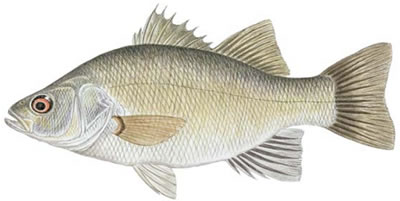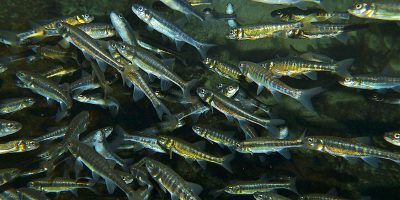You can’t beat fishing in perch if you’re hunting for enjoyable, fast catches and plenty of tasty fish. In North America, there are many types of perch. They can be found in freshwater and saltwater, and several species exist in both. But what does a perch fish look like?
About The Perch Fish
Perch is a common name for Perca fish, freshwater gamefish of the Percidae family. The perch, three of which occur in various regions, gives its name to many vertebrates. Most freshwater gamefish species more or less resemble perch but are of numerous genera.
Indeed, the red drum that lives only in saltwater is often referred to as a red perch, although by definition it is freshwater fish. Although many fish are called perch and are considered to be a real perch, the fish must be of the Percidae family.

With almost 165 species in its family tree, freshwater perch is probably North America’s most abundant fish. In the lakes, rivers, and streams of almost every fifty states and most Canadian provinces, you can find a common sport trout, yellow perch, often referred to as a lake perch.
The abundance – not to mention their tasty, firm meat – may explain why many anglers are hooked into catching fried fish that became popular trendy on Friday night. Perch feed all year, which increases their popularity, and they can be found all year round.
What Does A Perch Fish Look Like
Three forms to distinguish a perch are available. What does a perch fish look like? Here’s a guide to help!
Color
The back and head are greenish to brownish. The fish’s faces are
Yellow or white-yellowish. There are 6 to 9 vertical stripes on the sides of the perch. These stripes are dark. The bowels are white or gray.
Fins
The fin on a fish’s back is known as a dorsal fin. Perch’s got two
Dorsal fins separated. The front fin is a sharp, spiny fin. The back fin is referred to as a soft ray fin.
Form
A slender perch has a long body. Also, the perch is usually 6 to 12 inches big. But they grow bigger sometimes. The tail of a perch is somewhat forked.
What Does A Perch Fish Look Like: Silver Perch
Silver Perch is the first and smallest fish on our list. These little boxes, also known as Sand Perch, typically weigh less than half a pound. The IGFA has no recordset yet, but it is about one foot long.
Despite its name, Silver Perch is also a drum animal. They have a close connection with redfish and weakfish.

They like hanging out in tidal creeks, coastal bays and shallow seagrasses like their big brothers. If you’ve ever been on an eastern coastal fishing tour, you ‘re sure to see them at least once.
Silver Perch did not throw up a lot of resistance. They are perfect for children or beginners, but they are not a big focus for seasoned fishers.
Users find them primarily in large stripers or reds as bait to lure. However, don’t send them all to fish. Silver Perch is excellent to eat if they’re large enough to get fillet.
What Does A Perch Fish Look Like: White Perch
White Perch may not look much, but they are by far the most appropriate fish in our list. They occur in shallow saltwater on the Eastern Slope, estuaries, rivers, and the five Great Lakes.
They get around. The explanation is that it is a temperate bass that migrates into freshwater to breed much like striped bass.

White Perch can be affiliated with stripers, but not as tall. The world record is 3 pounds 8 ounces, but the bulk of fish are only 1 pound or less. Larger fish, mind you, can still be fun to catch. They even rival crappies in the hearts of some anglers.
Just like the rest of the family, Temperate Bass, White Perch is delicious. You have a white, firm, flaky flesh that is good to eat. Also, they ‘re not a big objective.
There are typically bigger and tastier fish around in saltwater. White Perch can be hit and missed in freshwater – either a bunch of them or none at all. This turns fishers into more comfortable tables.
What Does A Perch Fish Look Like: Yellow Perch
Enter the Perch fish king. Yellow Perch is one of North America’s most common freshwater species. They live in lakes throughout the United States and southern Canada. Wherever they turn up, hundreds of fishers capture them.
What’s different about Yellow Perch? Firstly, in North America, they are the only ones in the Perch (Percidae) family.
We look much better with their fantastic fins, light, and prominent lines than White or Silver Perch. Most notably, they are by far the tastiest fish on the list.
Many Yellow Perch weigh a pound high. A 12-ouncer is a good grab. Nonetheless, they can get even higher. The IGFA record currently stands at 4 pounds 3 ounces.

Habitat
Yellow Perch is found in a wide range of cool and warm habitats across a wide variety of territories, even if mainly lake fish. We are also present in wetlands and occasionally in waterways. These fish are common in dry, weedy lakes with a floor of muck, clay, or gravel.
Smaller lakes and pools usually produce smaller fish, although yellow perch can grow big in very fertile lakes with moderate fishing pressure.
They live in open regions of most of the lakes and prefer temperatures between the mid-sixties and the low seventies.
Food
Feed for the members of their genus is created from larger zooplankton, larvae, young crayfish, snails, marine larvae, fish eggs, and small fish.
They are generally expected to feed in the shallows at dawn and darkness and to remain inactive at night, but the conditions under which they feed and are caught differ widely with their environment and the angler ‘s skill.
Angling
The yellow perch are not tough fighters, but they engage the angler in feisty combat in cold water and in light spinning or spinning gear.
Their inclination to avert turbid and muddy surroundings and live in a clean and cool environment is responsible for the whiteness of their firm flesh, which is equivalent to their cousin’s highly prestigious walleye.
Yellow Perch is a school fish, and fishers land them during the season in open water; they are among the most common ice-fishing species.
They are also captured during their spring spawning runs, which involve ascending taxis and searching for warm coastal areas in bays and backdrops.
Yellow perch, mostly, is like cold water and schools depth wherever surface temperatures are dry, even though they are shallower to eat.
The best fishing spots are often weed beds in shallow lakes, where fishing on or near the bottom is advisable.
Yellow perch are taken on various attractions, with live worms, live tiny sticks, jigs, jig-and-spinner pairs, spoons, and spinners among the most robust attractors. Particularly productive are small jigs with hair or curl-tail bodies.
Importance of Perch
Perch has a significant effect on food, leisure, and ecological influences.
Perch is very common in a culinary sense in any restaurant that you can dine anywhere in the world. They are considered as one of the best-known and flavored pan-fish dishes.
For some restaurants, most of their fish menus are usually called perch. It’s of some other unrelated species, however.

Since perch is very common and well-known in any form of water, they are one of the most popular fish for fishing. They are also popular for hunting for family trips and other casual hunting because of their overpopulation.
Ecologically speaking, perch fish are important in maintaining the balance of the aquatic food chain.
In their early stage, they consume zooplankton and subsequently microinvertebrates. Eventually, as they get a little bigger, they feed on smaller fish. When they are sufficiently meaty, they are now the prey to other larger fish predators, including various birds.
Catching A Perch
Perch are known to be famous bait thieves, so you must make sure it is a sure lock when this fish is coming. Use a short hook to deter the perch from swimming.
Also, keep it on your hook when you attach your bait to increase your chance of a steady hook whenever a perch tries to hit it. If a perch bites, slowly pull it because you don’t want to pull the hook out of your mouth.
Many anglers like a disgorger while they catch perch with live bait. The problem with a pole is that they prefer to drop the hook without capturing or swallowing it.
Most fishers believe the perch is indeed a well-rounded game. Not to mention, there is a fishing hack to capture more prominent perch daily. This fish species is usually located at different depths. Half the population appears to find food on the field.
A good angler would also be sufficiently careful to travel with the flow. Take the time to search them regularly in the deeper parts. First, you should position your bait on the base and move slowly towards the surface to cover all the different depths.
Final Words
The perch is distinguished by its yellowish color, though it may differ often depending on its age and water clarity. These are meat-eating, freshwater trout, and are typically found in streams, lakes, ponds, and reservoirs.
Perch may grow up to 5 lb or more! However, don’t get your hope because a pole usually weighs approximately 1 lb or less. Therefore, if you ever capture a perch weighing about 2 lb or more, you have a trophy trout.


